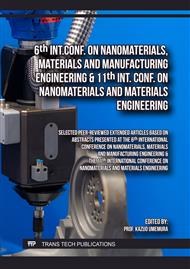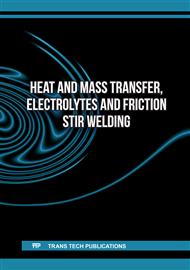p.3
p.9
p.15
p.21
p.29
p.35
p.45
p.55
Experiment Design and Process Optimization for Aging Friction Stir Welds in 6061 Aluminum Alloy
Abstract:
This study conducts a comprehensive analysis of changes in mechanical behaviours exhibited by friction stir welds created from 6061 Aluminium alloy after post-weld heat treatment (PWHT). The weld’s aging temperature plus duration were carefully regulated by technological parameters during its execution. The resulting data consists of the tensile strength, microstructure (including the size of grain as well as the morphology of the β phase that were precipitated), and distribution of hardness on the weld’s cross-section. Subsequent aging treatments affect the β phase, initially fine and dispersed, which tends to coalesce and grow more pronouncedly with increasing aging temperatures. A distinctive W-shaped hardness pattern was evident within the weld, indicative of enhanced hardness in particular zones in specimens aged at elevated temperatures due to intensified β phase precipitation. Correspondingly, tensile strength of the welds demonstrates an increasing trend with higher aging temperatures, albeit accompanied by reduced ductility. As per the findings, optimal mechanical properties were achieved by aging the 6061 aluminum alloy friction stir welds at 195°C for 7 hours. Furthermore, there was a considerable augmentation of hardness and tensile strength, coupled with a pronounced diminution in elongation when compared to the weld that was not subjected to heat treatment.
Info:
Periodical:
Pages:
21-26
Citation:
Online since:
May 2025
Authors:
Price:
Сopyright:
© 2025 Trans Tech Publications Ltd. All Rights Reserved
Share:
Citation:



